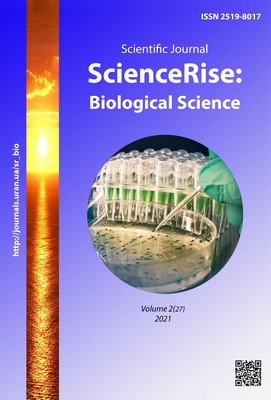The study of the fatty acid composition of common lilac flowers of “Madame Lemoine” variety
DOI:
https://doi.org/10.15587/2519-8025.2021.235525Keywords:
Common Lilac (Syringa vulgaris), fatty acids, gas chromatography, palmitic acidAbstract
An important place in human nutrition is occupied by omega-3, omega-6 and omega-9 fatty acids (FA). They have different effects on the human body and play a significant role in the appearance and the course of some diseases (for example, cardiovascular system, gastrointestinal tract, cancer, obesity, etc.).
The aim. To study the qualitative composition and the quantitative content of fatty acids in Common Lilac (Syringa vulgaris) flowers of “Madame Lemoine” variety.
Materials and methods. The fatty acid composition was studied by gas chromatography based on the formation of methyl esters of fatty acids and their subsequent determination.
Results and discussion. The presence and the quantitative content of 15 fatty acids have been determined. Among them, 13 FA have been identified, namely 6 saturated fatty acids and 7 unsaturated fatty acids. The total amount of saturated fatty acids (54.65 %) significantly predominates over unsaturated fatty acids (34.81 %). Palmitic acid dominates among saturated FA (39.83 %). Linoleic acid has the highest percent among unsaturated FA (13.75 %).
Conclusions. For the first time the composition of fatty acids in Common Lilac flowers of “Madame Lemoine” variety has been studied. The raw material accumulates saturated fatty acids in a significant number. Palmitic acid (C 16 : 0) – 39.83 % and linoleic acid (C 18 : 2) – 13.75 % are the dominant acids
References
- Kyslychenko, V. S., Zhuravel, I. O., Marchyshyn, S. M., Minarchenko, V. M., Khvorost, O. P. (2015). Farmakohnoziia. Kharkiv: NFaU: Zoloti storinky, 736.
- Sokoła-Wysoczańska, E., Wysoczański, T., Wagner, J., Czyż, K., Bodkowski, R., Lochyński, S., Patkowska-Sokoła, B. (2018). Polyunsaturated Fatty Acids and Their Potential Therapeutic Role in Cardiovascular System Disorders – A Review. Nutrients, 10 (10), 1561–1582. doi: http://doi.org/10.3390/nu10101561
- Tur, J. A., Bibiloni, M. M., Sureda, A., Pons, A. (2012). Dietary sources of omega 3 fatty acids: public health risks and benefits. British Journal of Nutrition, 107 (S2), S23–S52. doi: http://doi.org/10.1017/s0007114512001456
- Johnson, M. (2014). Omega-3, Omega-6 and Omega-9 Fatty Acids: Implications for Cardiovascular and Other Diseases. Journal of Glycomics & Lipidomics, 4 (4), 123–131. doi: http://doi.org/10.4172/2153-0637.1000123
- Albracht-Schulte, K., Kalupahana, N. S., Ramalingam, L., Wang, S., Rahman, S. M., Robert-McComb, J., Moustaid-Moussa, N. (2018). Omega-3 fatty acids in obesity and metabolic syndrome: a mechanistic update. The Journal of Nutritional Biochemistry, 58, 1–16. doi: http://doi.org/10.1016/j.jnutbio.2018.02.012
- Jing, K., Wu, T., Lim, K. (2013). Omega-3 Polyunsaturated Fatty Acids and Cancer. Anti-Cancer Agents in Medicinal Chemistry, 13 (8), 1162–1177. doi: http://doi.org/10.2174/18715206113139990319
- Mozaffarian, D., Wu, J. H. Y. (2011). Omega-3 Fatty Acids and Cardiovascular Disease. Journal of the American College of Cardiology, 58 (20), 2047–2067. doi: http://doi.org/10.1016/j.jacc.2011.06.063
- Kislichenko, V. S., Korol, V. V., Popik, A. I. (2009). Study of tocoferol and fatty acid composition bark, leaves, flower of syringa vulgaris. Ukrainian biopharmaceutical journal, 1 (2), 31–34.
- Korol, V. V., Popik, A. I. (2018). Fitokhimichne doslidzhennia kvitok buzku zvychainoho sortiv Misiachne siaivo, Mriia, Nadiia. Current approaches of pharmaceutical science in development and standardization of medicines and dietary supplements that contain components of natural origin. Kharkiv: NFaU, 66.
- Popik, A. I., Kislichenko, V. S. (2018). Izuchenie elementnogo sostava tsvetkov sireni obyknovennoy ukrainskogo sorta «Mechta». Rol i mesto innovatsionnykh tekhnologiy v sovremennoy meditsine. Dushanbe, II, 394–396.
- Protska, V. V., Kislichenko, O. A., Zhuravel, І. O. (2016). The analysis of Hosta lancifolia rhizomes with roots, leaves and flowers fatty acid. ScienceRise: Pharmaceutical Science, 2 (2), 24–29. doi: http://doi.org/10.15587/2519-4852.2016.75073
- Carta, G., Murru, E., Banni, S., Manca, C. (2017). Palmitic Acid: Physiological Role, Metabolism and Nutritional Implications. Frontiers in Physiology, 8. doi: http://doi.org/10.3389/fphys.2017.00902
Downloads
Published
How to Cite
Issue
Section
License
Copyright (c) 2021 Аndrii Popyk, Viktoriia Kyslychenko, Viktoriia Velma

This work is licensed under a Creative Commons Attribution 4.0 International License.
Our journal abides by the Creative Commons CC BY copyright rights and permissions for open access journals.
Authors, who are published in this journal, agree to the following conditions:
1. The authors reserve the right to authorship of the work and pass the first publication right of this work to the journal under the terms of a Creative Commons CC BY, which allows others to freely distribute the published research with the obligatory reference to the authors of the original work and the first publication of the work in this journal.
2. The authors have the right to conclude separate supplement agreements that relate to non-exclusive work distribution in the form in which it has been published by the journal (for example, to upload the work to the online storage of the journal or publish it as part of a monograph), provided that the reference to the first publication of the work in this journal is included.









